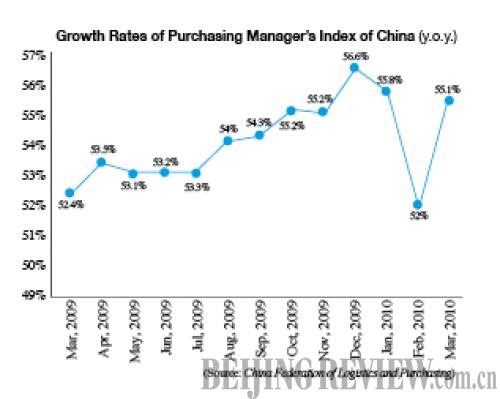| 
Numbers of the Week
16.06 million
The number of 3G users in China has maintained continuous growth, reaching 16.06 million by the end of February, according to figures released on March 31 by the Ministry of Industry and Information Technology.
76.06 million
China produced 76.06 million bicycles in 2009, a decline of 13.2 percent from the previous year, said Ma Zhongchao, Director of the China Bicycle Industry Association.
TO THE POINT: The Social Security Fund received 65 billion yuan ($9.5 billion) worth of listed stocks transferred from state shareholders by March 29. Chinese shipbuilders lost ground to their South Korean rivals that scooped up orders by slashing prices. The eye-popping 12-trillion-yuan ($1.76-trillion) investment package of central China's Hubei Province raises hopes and eyebrows. The World Gold Council said China's gold demand is expected to double in a decade. China Central Huijin Investment Ltd. is expected to rake in record-high dividends from the country's big three banks in 2009.
By HU YUE
Funding Retirement
State shareholders had transferred nearly 65 billion yuan ($9.5 billion) worth of stocks in listed companies to the Social Security Fund (SSF) by March 29, according to a statement from the SSF.
On June 19, 2009, the government ordered 10 percent of state-owned stocks in companies listed after the 2005-06 shareholding reform be transferred to the fund free of charge.
This move was largely designed to shore up the financial position of the fund, a strategic reserve of the country established in August 2000 to meet the future pension needs of an aging population. The SSF obtained capital from the Central Government, sales of lottery tickets and returns on investments. But its capital distress grew in the recent years as more Chinese reached retirement age.
In an effort to address the aging problem, the fund aims to boost its asset portfolio to 2 trillion yuan ($292.9 billion) by 2015 from the current 776.5 billion yuan ($113.7 billion), said Dai Xianglong, Chairman of the National Council for the SSF.
As a long-term value investor, the fund sees the bright prospects presented by the Chinese stock markets, and is also gearing up to spread its wings abroad, said Dai.
"We are planning to build a heavier presence in foreign stocks, bonds as well as unlisted corporate equities," added Dai.
Stuck in Port
Nearly two years after the financial crisis, China's shipbuilding industry has yet to set sail again.
Chinese shipbuilders received new orders of only 159,000 deadweight tons in January 2010, barely 10 percent of that of South Korea, according to London-based Clarkson ship brokers. Meanwhile, many owners are seeking to postpone deliveries or cancel them outright since they have no cargo to ship.
A lack of financing that helps keep shipbuilding afloat has only added to the industry's woes. The deep downturn means yards are taking in few down payments on new orders that were typically used to finance ship construction.
South Korean competitors have taken this opportunity to grab market shares by depressing prices, said Wang Jinlian, Secretary General of the China Association of the National Shipbuilding Industry.
Of course, the competition will also be a powerful catalyst for Chinese shipbuilders to strengthen efficiency and sharpen their competitive edge, he added.
China overtook South Korea as the world's biggest shipbuilder in the first half of 2007 by winning more orders in terms of deadweight tonnage, but South Korea remained far ahead in manufacturing high-end products, like LNG (liquefied natural gas) ships.
Liang Zhiyong, a senior analyst with the China Shipbuilding Industry Economy Research Center, also struck a note of caution. "Darker days may lie ahead for the industry given the chronic overcapacity problem and the deteriorating global trade," he said.
The past few years have seen a number of small private yards spring up across the country, building excess capacity that would take years to absorb.
Hubei's Stimulus Plan
By announcing a jaw-dropping 12-trillion-yuan ($1.76-trillion) investment package, central China's Hubei Province stunned the world.
The program is three times the country's 4-trillion-yuan ($586 billion) stimulus package announced in November 2008, and nearly 10 times the province's GDP in 2009.
The massive projects, 30 percent of which are focused on infrastructure, will cover a range of sectors including manufacturing, services, agriculture and environmental protection, and will be implemented over the next few years, said Xu Kezhen, Director of Hubei Provincial Development and Reform Commission, at a meeting on March 22.
| 